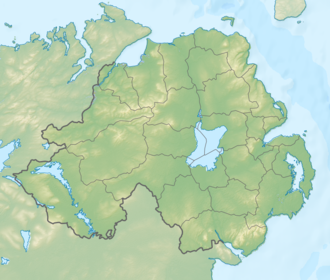| Donard Forest | |
|---|---|
 A path within Donard Forest | |
| Map | |
| Geography | |
| Location | Down,Northern Ireland,United Kingdom |
| Coordinates | 54°12′11″N5°54′07″W / 54.203°N 5.902°W |
| Area | 296.82 hectares (733.5 acres) |
| Administration | |
| Governing body | Forest Service Northern Ireland |
Donard Forest is located near Newcastle, County Down, Northern Ireland. It borders Donard Park at the foot of the Mourne Mountains. The Glen River flows through the forest where it is crossed by three stone bridges. The north east section of the forest contains a Heritage Stand of Scots and Corsican pine planted in 1927. A south east section, beside the Glen River, was the former site of Donard Lodge, built in the 1830s and later demolished. There are a number of exotic trees in the area surrounding the site of the house, including Giant Redwoods and Monkey Puzzles.


